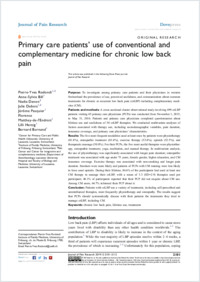Primary care patients’ use of conventional and complementary medicine for chronic low back pain
- Rodondi, Pierre-Yves Center for Primary Care and Public Health (Unisanté), University of Lausanne, Switzerland - Institute of Family Medicine, University of Fribourg, Switzerland
- Bill, Anne-Sylvie Center for Primary Care and Public Health (Unisanté), University of Lausanne, Switzerland
- Danon, Nadia Pain Center and Center for integrative and complementary medicine, Department of Anesthesiology, Lausanne University Hospital and Faculty of Biology and Medicine, University of Lausanne, Switzerland
- Dubois, Julie Center for Primary Care and Public Health (Unisanté), University of Lausanne, Switzerland - Institute of Family Medicine, University of Fribourg, Switzerland
- Pasquier, Jérôme Center for Primary Care and Public Health (Unisanté), University of Lausanne, Switzerland
- Matthey-de-l'Endroit, Florence Center for Primary Care and Public Health (Unisanté), University of Lausanne, Switzerland
- Herzig, Lilli Center for Primary Care and Public Health (Unisanté), University of Lausanne, Switzerland
- Burnand, Bernard Center for Primary Care and Public Health (Unisanté), University of Lausanne, Switzerland
-
2019
Published in:
- Journal of Pain Research. - 2019, vol. Volume 12, p. 2101–2112
English
To investigate among primary care patients and their physicians in western Switzerland the prevalence of use, perceived usefulness, and communication about common treatments for chronic or recurrent low back pain (crLBP) including complementary medicine (CM). Patients and methods: A cross-sectional cluster observational study involving 499 crLBP patients visiting 45 primary care physicians (PCPs) was conducted from November 1, 2015, to May 31, 2016. Patients and primary care physicians completed questionnaires about lifetime use and usefulness of 30 crLBP therapies. We conducted multivariate analyses of factors associated with therapy use, including sociodemographic variables, pain duration, insurance coverage, and primary care physicians’ characteristics. Results: The five most frequent modalities used at least once by patients were physiotherapy (81.8%), osteopathic treatment (63.4%), exercise therapy (53.4%), opioids (52.5%), and therapeutic massage (50.8%). For their PCPs, the five most useful therapies were physiotherapy, osteopathic treatment, yoga, meditation, and manual therapy. In multivariate analysis, the use of physiotherapy was significantly associated with longer pain duration; osteopathic treatment was associated with age under 75 years, female gender, higher education, and CM insurance coverage. Exercise therapy was associated with non-smoking and longer pain duration. Smokers were more likely and patients of PCPs with CM training were less likely to have used opioids. During their lifetime, 86.6% of the participants had used at least one CM therapy to manage their crLBP, with a mean of 3.3 (SD=2.9) therapies used per participant; 46.1% of participants reported that their PCP did not enquire about CM use. Among CM users, 64.7% informed their PCP about it. Conclusion: Patients with crLBP use a variety of treatments, including self-prescribed and unreimbursed therapies, most frequently physiotherapy and osteopathy. The results suggest that PCPs should systematically discuss with their patients the treatments they tried to manage crLBP, including CM.
- Faculty
- Faculté des sciences et de médecine
- Department
- Master en médecine
- Language
-
- English
- Classification
- Medicine
- License
-
License undefined
- Identifiers
-
- RERO DOC 326986
- DOI 10.2147/JPR.S200375
- Persistent URL
- https://folia.unifr.ch/unifr/documents/307902
Statistics
Document views: 127
File downloads:
- pdf: 146
